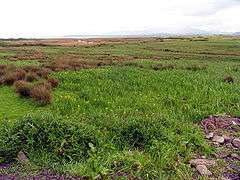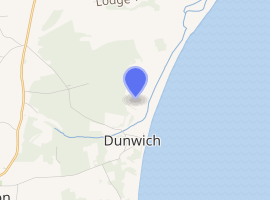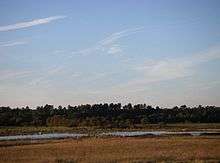Dingle Marshes
Dingle Marshes is a 93 hectares (230 acres) wildlife reserve on the North Sea coast of the English county of Suffolk. The reserve is located between Dunwich and Walberswick, approximately 4 miles (6.4 km) south-west of Southwold. The marshes make up part of the Suffolk Coast National Nature Reserve along with reserves at Walberswick and Hen Reedbeds.[1][2] They are owned jointly by the RSPB and Suffolk Wildlife Trust and are managed by these two organisations and Natural England.[2][3] The site is in the Dunwich Heaths and Marshes Nature Conservation Review site, Grade I,[4] the Minsmere-Walberswick Ramsar internationally important wetland site,[5] the Minsmere to Walberswick Heaths and Marshes Special Area of Conservation,[6][7] and the Minsmere-Walberswick Special Protection Area under the European Union Directive on the Conservation of Wild Birds.[8][9]
| Dingle Marshes | |
|---|---|
 | |

| |
| Type | Nature reserve |
| Location | Dunwich, Suffolk |
| OS grid | TM479708 |
| Area | 93 hectares |
| Managed by | Suffolk Wildlife Trust |
It is also within the Minsmere-Walberswick Heaths and Marshes Site of Special Scientific Interest and is a Natura 2000 site.[3] It is an internationally important site for the starlet sea anemone as well as a key site for bitterns and marsh harriers within the UK.[1] It was purchased in 1999 at a cost of £1 million, aided by a grant from the Heritage Lottery Fund of £559,000.[10]
Landscape
The marshes form part of the open coastal fen landscape type within Suffolk which is predominantly open with few trees.[11] They were drained for use as cattle grazing at some point before 1587 but have reverted to fen land after mid-20th century reflooding.[11]
Habitat

The marshes include a mixture of coastal and freshwater wetland habitats, including brackish pools.[12] These provide breeding habitats for birds such as bitterns, marsh harriers and bearded tits as well as mammals such as otters and water vole and over-wintering locations for species such as avocets, white-fronted geese, lapwings and redshanks.[1][3][12] The site is an internationally important habitat of the starlet sea anemone, the rarest sea anemone in Britain.[1][3] The reserve is bordered by heathland and forest on the landward side and includes a vegetated shingle bank on the seaward side. Little terns often nest along the bank.[12]
Flooding
Coastal flooding has affected the marshes in recent years, including in 2003, 2006 and 2007.[13][14] The shingle bank was breached in 2006 and 2007 leading to concerns that vulnerable freshwater habitats could be lost, including the breeding grounds of species such as bitterns.[13][14][15] Emergency flood defence works were carried out by the Environment Agency following the 2006 breach,[15] and these were extended in 2012 to provide additional flood defences for the reserve.[16]
Facilities
The reserve is accessed from the south at Dunwich beach where a car park and other facilities are maintained by Suffolk Coastal District Council. A circular walk is waymarked around the marshes. The RSPB maintains a hide overlooking the marsh.[12]
References
- Suffolk Coast NNR, Natural England. Retrieved 30 October 2012.
- Suffolk Coast National Nature Reserve Archived 14 October 2012 at the Wayback Machine, Direct enquiries. Retrieved 30 October 2012.
- Dingle Marshes, Suffolk Wildlife Trust. Retrieved 30 October 2012.
- Ratcliffe, Derek, ed. (1977). A Nature Conservation Review. 2. Cambridge, UK: Cambridge University Press. pp. 210–211. ISBN 0521 21403 3.
- "Information Sheet on Ramsar Wetlands (RIS): Minsmere–Walberswick" (PDF). Joint Nature Conservation Committee. Retrieved 4 May 2017.
- "Minsmere to Walberswick Heaths and Marshes". Special Areas of Conservation. Joint Nature Conservation Committee. Retrieved 4 May 2017.
- "Designated Sites View: Minsmere to Walberswick Heaths & Marshes". Special Area of Conservation. Natural England. Retrieved 5 May 2017.
- "Special Protection Areas under the EC Birds Directive. Minsmere-Walberswick" (PDF). Joint Nature Conservation Committee. Retrieved 4 May 2017.
- "Designated Sites View: Minsmere-Walberswick". Special Protection Area. Natural England. Retrieved 5 May 2017.
- Lottery helps rare species, BBC news website, 10 February 1999. Retrieved 2012-10-31.
- Open coastal fens, Suffolk county council. Retrieved 30 October 2012.
- About Dingle Marshes, RSPB. Retrieved 30 October 2012.
- Sea breaches RSPB reserves in Suffolk Archived 23 September 2015 at the Wayback Machine, Bird Guide, 2 November 2006. Retrieved 2012-10-30.
- Surge hits wildlife havens, BBC news website, 9 November 2007. Retrieved 2012-10-31.
- Fears for Dingle marshes Archived 24 September 2015 at the Wayback Machine, Eastern Daily Press, 3 January 2007. Retrieved 2012-10-30.
- Flood protection work at Minsmere and Dingle Marshes, BBC news website, 15 October 2012. Retrieved 2012-10-30.
| Wikimedia Commons has media related to Dingle Marshes. |